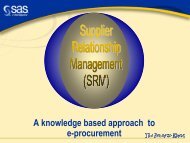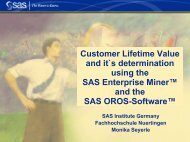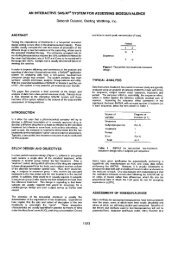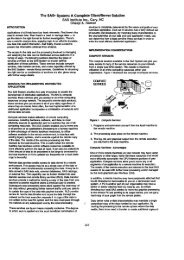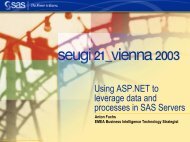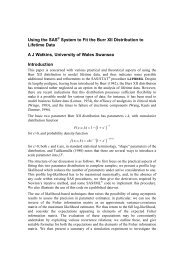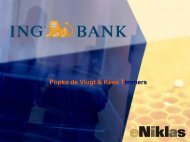An Introduction to ODS Markup and Tagsets - sasCommunity.org
An Introduction to ODS Markup and Tagsets - sasCommunity.org
An Introduction to ODS Markup and Tagsets - sasCommunity.org
You also want an ePaper? Increase the reach of your titles
YUMPU automatically turns print PDFs into web optimized ePapers that Google loves.
<strong>An</strong> <strong>Introduction</strong> <strong>to</strong> <strong>ODS</strong><br />
<strong>Markup</strong> <strong>and</strong> <strong>Tagsets</strong><br />
Arthur Witherall
<strong>Markup</strong> His<strong>to</strong>ry<br />
• HTML was the original markup language of<br />
the web<br />
– There are set tags <strong>and</strong> attributes<br />
– It is difficult <strong>to</strong> change styles quickly<br />
• CSS allows developers <strong>to</strong> construct their own<br />
styles<br />
• XML allows developers <strong>to</strong> construct their own<br />
tags <strong>and</strong> attributes
The SAS Solution: <strong>ODS</strong><br />
<strong>Markup</strong><br />
• Release 8.1 provided limited capacity <strong>to</strong><br />
export SAS output <strong>to</strong> HTML <strong>and</strong> XML<br />
documents<br />
• Release 8.2 extends this facility <strong>to</strong><br />
incorporate a wide variety of markup<br />
languages:<br />
– CHTML<br />
– PHTML<br />
– CSV<br />
– DTDs<br />
– XSL<br />
– LATEX<br />
– GTABLEAPPLET<br />
– WML
The SAS Solution: <strong>ODS</strong><br />
<strong>Markup</strong><br />
• There are several actions available in the<br />
<strong>ODS</strong> <strong>Markup</strong> Statement:<br />
– CLOSE<br />
– EXCLUDE<br />
– SELECT<br />
– SHOW<br />
• The syntax for the statement is:<br />
ods markup action ;<br />
ods markup file-specification(s) ;
The SAS Solution: <strong>ODS</strong><br />
<strong>Markup</strong><br />
• To export SAS procedural output <strong>to</strong> a<br />
specific markup language, use the<br />
TAGSET | TYPE option<br />
• Example:<br />
ods markup tagset = phtml ;
The SAS Solution: <strong>ODS</strong><br />
<strong>Markup</strong><br />
• You may also develop your own<br />
tagsets, suited <strong>to</strong> your own requirements<br />
• Sample SAS code:<br />
ods _all_ close;<br />
ods markup tagset = tagset_name<br />
body =_webout (no_<strong>to</strong>p_matter no_bot<strong>to</strong>m_matter)<br />
style =minimal<br />
;
<strong>Tagsets</strong><br />
• A tagset is a kind of template<br />
• <strong>Tagsets</strong> are defined using Proc Template<br />
• They are particularly useful in altering a<br />
large group of web pages
<strong>Tagsets</strong><br />
• To get a list of the SAS-supplied tagsets<br />
included in the general template, use the<br />
following code:<br />
proc template;<br />
list tagsets;<br />
• These tagsets were downloaded from:<br />
http://www.sas.com/rnd/base/index-ods-resources.html
<strong>Tagsets</strong><br />
• To see the source for a tagset definition,<br />
specify the two-level name of the tagset<br />
within Proc Template.<br />
• The code will then appear in the SAS log.<br />
proc template ;<br />
source tagsets.chtml;
Writing the Tagset <strong>to</strong> the<br />
SASHELP Catalog<br />
• Problem: the SASIntrNet Server<br />
SASUSER catalog may be read-only<br />
• Solution: write the tagset <strong>to</strong> the SASHELP<br />
catalog instead<br />
• Use <strong>ODS</strong> Path (Update <strong>and</strong> Read options)
Code for this Solution<br />
<strong>ODS</strong> PATH SHOW;<br />
<strong>ODS</strong> PATH SASHELP.TMPLMST(UPDATE) SASUSER.TEMPLAT(UPDATE);<br />
proc template;<br />
define tagset test;<br />
parent=tagsets.htmlcss;<br />
define event data;<br />
trigger header /if cmp(htmlclass,"colhd");<br />
break /if cmp(htmlclass,"colhd");<br />
put "";<br />
put VALUE CR;<br />
end;<br />
end;<br />
run;<br />
<strong>ODS</strong> PATH SASHELP.TMPLMST(READ) SASUSER.TEMPLAT(UPDATE);<br />
<strong>ODS</strong> PATH SHOW;<br />
<strong>ODS</strong> LISTING CLOSE;
Events<br />
• A tagset consists in a series of events<br />
• <strong>An</strong> event is a creative addition <strong>to</strong> output<br />
• Events are defined using “start” <strong>and</strong><br />
“finish” statements<br />
• Prevent events from happening by using<br />
“break” <strong>and</strong> conditional processing
Triggers<br />
• <strong>An</strong> event may be triggered from within<br />
another event<br />
• Example:<br />
define event headalign;<br />
break / when !any(JUST, VJUST);<br />
trigger valign / when !exists(JUST);<br />
trigger hhalign / when !exists(VJUST);<br />
break / when !exists(JUST, VJUST);<br />
trigger valign / when cmp("l", JUST);<br />
trigger hhalign / when cmp("c", VJUST);<br />
break / when cmp("l", JUST);<br />
break / when cmp("c", VJUST);<br />
put ' id="' JUST / when !cmp("d", JUST);<br />
put ' id="l' / when cmp("d", JUST);<br />
put VJUST;<br />
put '"';<br />
end;
Conditions on Events<br />
• There are new SAS statements for<br />
assigning conditions on events:<br />
– PUTQ places text, or the value of a variable,<br />
in<strong>to</strong> the output, <strong>and</strong> puts quotation marks<br />
around it<br />
– PUTL places text, or the value of a variable,<br />
in<strong>to</strong> the output, <strong>and</strong> moves down one line
Conditions on Events<br />
– CMP compares text with the value of a<br />
variable<br />
– IF <strong>and</strong> WHEN are generally equivalent; they<br />
are used with CMP <strong>to</strong> determine when a PUT<br />
statement will be invoked<br />
– EXISTS determines if the variable has any<br />
value at all<br />
– ! is used as the boolean negation; read as<br />
“not”
Variables<br />
• Variables are data-driven<br />
driven<br />
• There are style variables <strong>and</strong> event<br />
variables<br />
• Event variables are unique <strong>to</strong> tagsets; eg.<br />
– date, time, names, ods path, value, url<br />
– width, colstart, colcount, row, rowspan<br />
• Style variables control the appearance of<br />
your output
Examples of Style Variables<br />
Style Variable<br />
BACKGROUND<br />
Holds the value for...<br />
color of the background.<br />
BODYSCROLLBAR<br />
CELLHEIGHT<br />
CELLPADDING<br />
FLYOVER<br />
FONT<br />
FONT_SIZE<br />
FONT_STYLE<br />
FRAME<br />
HREFTARGET<br />
HTMLCLASS<br />
HTMLID<br />
JUST<br />
HTMLSTYLE<br />
whether <strong>to</strong> put a scrollbar in the frame for the body file.<br />
height of the cell.<br />
amount of white space on each of the text in a cell.<br />
text <strong>to</strong> show in a <strong>to</strong>ol tip for the cell.<br />
font definition.<br />
size of the font.<br />
style of the font.<br />
type of frame <strong>to</strong> use on a table.<br />
window or frame in which <strong>to</strong> open the target of the link.<br />
name of the stylesheet class <strong>to</strong> use for the table or cell.<br />
id for the table or cell.<br />
horizontal justification.<br />
individual attributes <strong>and</strong> values for the table or cell.
Examples of Event Variables<br />
Event Variable Holds the value for ...<br />
AUTHOR<br />
author of the output. Set from the <strong>ODS</strong> statement or is<br />
the user that is running SAS.<br />
BASENAME<br />
COLCOUNT<br />
COLSPAN<br />
COLSTART<br />
COL_ID<br />
DATE<br />
NAME<br />
PATH<br />
REF_ID<br />
ROW<br />
VALUE<br />
BASE= option as set in the <strong>ODS</strong> statement.<br />
number of columns in the current table.<br />
number of columns that the cell spans.<br />
column number for which the cell starts.<br />
column ID <strong>to</strong> identify columns. Used for the OIMDBM<br />
format type by the XML LIBNAME engine.<br />
date.<br />
name of the variable. Set with the VARNAME= attribute<br />
path as set by the <strong>ODS</strong> statement.<br />
reference ID for references <strong>to</strong> columns. Used for the<br />
OIMDBM format type by the XML LIBNAME engine.<br />
current table row, which includes headers.<br />
current value.
Applications: Online<br />
Government St<strong>and</strong>ards<br />
• Metadata<br />
• Accessibility<br />
• Privacy
Applications: Accessibility<br />
PRIORITY ONE:<br />
1.1 -- Provide a text equivalent for every non-text element<br />
We put the title of all gifs in<strong>to</strong> "alt=" tags. This was difficult<br />
only in one case, which used a format.<br />
5.1 -- For data tables, identify row <strong>and</strong> column headers.<br />
This was achieved with tagsets.<br />
5.2 -- Use markup <strong>to</strong> associate data cells <strong>and</strong> header cells.<br />
Also achieved with tagsets.
Code for Accessibility<br />
proc template;<br />
define tagset access;<br />
parent=tagsets.htmlcss;<br />
define event data;<br />
trigger header_art /if cmp(htmlclass,"colhd");<br />
break /if cmp(htmlclass,"colhd");<br />
put "";<br />
put VALUE CR;<br />
finish:<br />
trigger header_art /if cmp(htmlclass,"colhd");<br />
break /if cmp(htmlclass,"colhd");<br />
trigger pre_post;<br />
put "" CR;<br />
end;
Code for Accessibility<br />
define event header_art;<br />
start:<br />
put "";<br />
put VALUE;<br />
finish:<br />
put "" CR;<br />
end;
<strong>Markup</strong> Output
<strong>Markup</strong> Output
<strong>Markup</strong> Output
<strong>Markup</strong> Output
Conclusion<br />
• <strong>ODS</strong> <strong>Markup</strong> - an alternative <strong>to</strong> <strong>ODS</strong><br />
HTML<br />
• <strong>Tagsets</strong> - enable the definition of new<br />
markup




